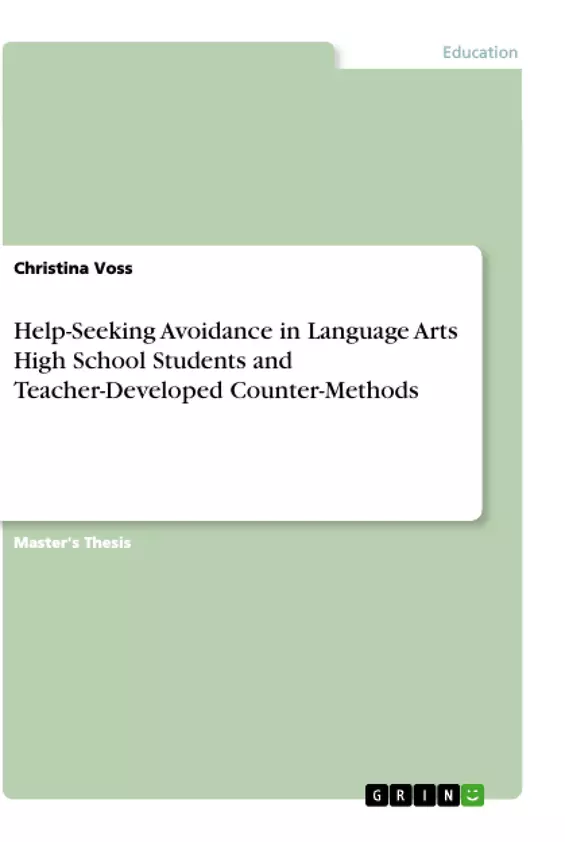Help-Seeking is a learning strategy which the self-regulated student can use to improve academic achievement. The purpose of this study is to find ways to enhance high school students’ understanding and learning, raise their grades, and lower the prevalence of task avoidance, faking, and cheating, by encouraging the students to seek more help than they usually would in Language Arts classrooms. Subjects to my study were 44 top track junior English students, 10 third track freshman English students, 14 junior honor German students, six Language Arts teachers, as well as four case studies. After investigating the reasons for help-seeking avoidance as well as help-seeking over-eliciting, I offered help in different areas – teacher-directed intervention, peer-review and collaborative learning, and technological/media support. Results indicated that in most students, the help-seeking behavior had not changed after my student teaching, but the majority acknowledged help tools such as writing conferences as important to attain higher grades. While some students used help tools, others rejected them openly. They know what is out there – remains to use it! The practical implications for the Language Arts classroom are discussed.
Inhaltsverzeichnis (Table of Contents)
- I. INSPIRATION AND INTRODUCTION
- A. Background
- B. Statement of the Problem
- C. Significance of the Study
- II. CONCEPTUAL FRAMEWORK AND RELATED LITERATURE
- A. Conceptual Framework
- B. Limitations and Weaknesses of the Past Research
- C. Review of Related Literature
- 1. Student Goals as Basis for Motivation
- 2. Defining Areas where Help is Needed
- 3. Reasons for Help-Seeking Behavior
- a. Students' Theories about Social Cognition and Academic Task
- b. Classroom Climate
- c. Teacher-Student Inter-Subjectivity
- i. Teachers' Willingness to Help
- ii. Teachers' Competence
- iii. Teachers' Negative Reaction
- iv. Teachers' Expectance
- v. Teachers' General Personality
- vi. Student-Teacher Relationship
- vii. Teachers' Predictability
- viii. Student-Teacher Familiarity
- ix. Teachers' Gender and Race
- x. Teachers' Mood
- 4. Students' Gender and Age
- 5. Achievement Level: Tracking, Ethnicity, and Language
- 6. Foreign Language Classroom
- 7. Teachers' Counter-Methods
- a. Writing Conferences
- b. Written Comments on Papers
- c. “Slang Dictionary” Extra Credit Project
- d. Graphic Novels, Poetry Comics, Hip Hop Poems, WebQuests, Blogs, Community Member Visits
- e. \"Sorrow Box\"\n
- D. Summary of Research Hypotheses and Research Questions
- III. METHODOLOGY
- A. Overview
- B. Participants
- 1. Classes and Teachers
- 2. Case Studies
- a. Jim-Bob
- b. Fabumi
- c. Tad
- d. Lys
- C. Methods
- 1. Quantitative Methods
- a. Pre-Survey
- b. Post-Survey
- c. STI-Scores for \"Slang Dictionary Project\"\n
- 2. Qualitative Methods
- a. \"Sorrow Box\"\n
- b. Writing Conferences
- e. Field Study: Student Observation in Third Track Class
- 1. Quantitative Methods
- IV. RESULTS and ANALYSIS
- A. Has the Students' Help-Seeking Behavior Changed Over the Year?
- B. Correlation Analyses
- 1. Foreign Language Anxiety and Help-Seeking in German
- 2. Help-Seeking and Race/Low-Income/GPA
- 3. Help-Seeking and Student/Teacher Perception
- 4. Help-Seeking and Classroom Climate
- C. Students' Preferred Ways of Help-Eliciting
- D. Students' Acceptance / Refusal of Offered Help Tools
- E. Summary of Help-Seeking Results
- V. DISCUSSION
- A. Overview
- B. Study Findings
- C. Implications for Classroom Practices
- D. Validity and Reliability
Zielsetzung und Themenschwerpunkte (Objectives and Key Themes)
The study aims to investigate the phenomenon of help-seeking avoidance in Language Arts high school students, exploring its underlying causes and developing effective counter-methods to encourage help-seeking behavior. The ultimate goal is to enhance students' understanding and learning, improve their academic performance, and reduce instances of task avoidance, faking, and cheating.
- Help-seeking avoidance in Language Arts classrooms
- Factors influencing students' willingness to seek help
- The role of teacher-student inter-subjectivity in help-seeking behavior
- Effective teacher-developed counter-methods to encourage help-seeking
- The impact of help-seeking on academic achievement
Zusammenfassung der Kapitel (Chapter Summaries)
Chapter I introduces the research topic, highlighting the significance of help-seeking as a learning strategy and the challenge of student avoidance in Language Arts classrooms. Chapter II delves into the conceptual framework, examining past research limitations and reviewing relevant literature on student goals, help-seeking motivations, classroom climate, and teacher-student inter-subjectivity. It also discusses various reasons for help-seeking avoidance, including students' theories about social cognition and academic tasks, classroom climate, and teacher-student interactions. The chapter concludes by outlining the different counter-methods teachers can employ to promote help-seeking.
Chapter III presents the methodology used in the study, outlining the participants, including both Language Arts students and teachers, as well as case studies. It details the quantitative and qualitative methods employed, such as surveys, "Sorrow Box," and writing conferences, for data collection. Chapter IV presents the results and analysis of the data collected, focusing on the changes in students' help-seeking behavior, correlation analyses, students' preferred help-eliciting methods, and their acceptance or rejection of help tools.
Schlüsselwörter (Keywords)
The study's main keywords and focus topics include help-seeking avoidance, help-seeking willingness scale, student goals, anxiety, self-perception, cognition, motivation, classroom climate, gender differences, tracking system, self-regulated learning, cooperative learning, teacher intervention, teacher-student inter-subjectivity, foreign language classroom anxiety scale.
- Citation du texte
- Dr. Christina Voss (Auteur), 2007, Help-Seeking Avoidance in Language Arts High School Students and Teacher-Developed Counter-Methods, Munich, GRIN Verlag, https://www.grin.com/document/1133085



